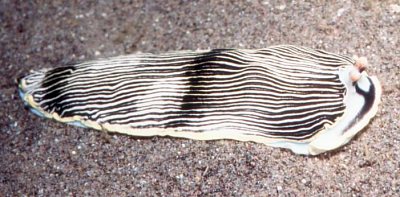
Armina cf. wattla
Marcus & Marcus, 1967
Order: NUDIBRANCHIA
Suborder: ARMININA
Family: Arminidae
DISTRIBUTION
Tropical west Atlantic
PHOTO
off the Caribbean Island of Dominica. July, 2002. Photo: Dave Elliott
Eveline Marcus (1977) in her checklist of warm water western Atlantic opisthobranchs, lists 3 species of Armina, including the Mediterranean species, Armina tigrina Rafinesque, 1814. The two species which were described from the western Atlantic are Armina mulleri (von Ihering, 1886) and Armina wattla Marcus, 1967. The colour of the living animal of Armina mulleri was redescribed by Marcus & Marcus (1967) as "has a black notum, with light ridges, a yellowish hyponotum and bright pink sole" Unfortunately there are many species with very similar colour patterns. However, although Armina wattla has only been reported once, [from Georgia, USA] features of its colour pattern do match this photo rather well. Unfortunately the Marcus' description is based on preserved animals, but they do describe the preserved animals as 'whitish with black pigment in the furrows between the notal ridges ... in the middle of the [oral] veil .....". In the drawings accompanying the description there is a black band running down the middle of the oral veil just as in your photo. However there is no mention that the back continues along the edge of the oral veil as well. There is a possibility your animal could be Armina wattla.
References:
• Marcus, Ev. & Marcus, Er. (1967) Some opisthobranchs from Sapelo Island, Georgia, U.S.A. Malacologia, 6(1-2): 199-222.
• Marcus, Er. & Marcus, Ev. (1967) American opisthobranch mollusks. Part 1, Tropical American opisthobranchs. Studies Tropical Oceanography, Miami, 6(1-2): 1-137. (Figs 1-150, Pl.1, figs 1-9)
• Marcus, Ev. (1977) An annotated checklist of the western Atlantic warm water opisthobranchs. J. Moll. Stud. (Suppl. 4): 1-23.
Rudman, W.B., 2002 (September 26) Armina cf. wattla Marcus & Marcus, 1967. [In] Sea Slug Forum. Australian Museum, Sydney. Available from http://www.seaslugforum.net/find/armicfwatt
Related messages
Smiling Armina from Bonaire
July 18, 2008
From: Ellen Muller


Dear Bill,
On a night dive in Bonaire, [Lesser Antilles, Caribbean] April 10th 2008, I found five "Smiling Arminas". One was dead and lying belly up in the sand. The other four were alive and healthy, crawling along the sand.
The next night I found six Armina in the same area. All were crawling on top of the sand. Near the end of the dive I came across a pair that I suppose was mating, one was partially buried in the sand and the other was almost completely buried.
I went back again the next night and found 7 Armina in the same area. The Armina were in an area that was approximately 50 ft in diameter and were found between 7 ft-13 ft depth. Their sizes ranged from approximately 3/4 inch to 3 inches long. The Armina that were crawling on the sand were not particularly close to one another, usually several feet apart from each other.
Over the next three weeks the Armina were still in the same area and on one evening I counted 13. I observed the Armina on several occasions hunting and feeding on the plentiful Sea Pansies in the area [lower photo ]. One of the juvenile Armina had no "smile".
I used a red light to photograph them because they would quickly bury themselves in the sand if disturbed by a white light.
Ellen Muller
ellen@imaginebonaire.com
Muller, E., 2008 (Jul 18) Smiling Armina from Bonaire. [Message in] Sea Slug Forum. Australian Museum, Sydney. Available from http://www.seaslugforum.net/find/21717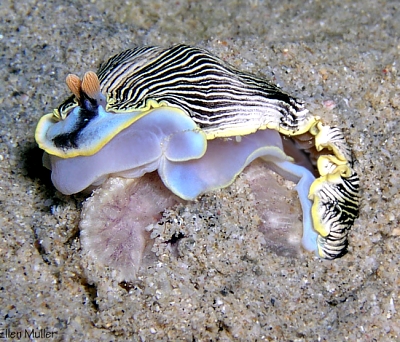
Dear Ellen,
Thanks for these interesting observations. I couldn't resist putting a couple of 'smiling' Armina at the top of your message. In fact that black mark on the oral lobe is, I think, a clue to its identity, and your photos showing some with a large smile, and others without, is a valuable link to the Marcus's original description of Armina wattla in which they illustrate a black median band just has seen in the animal eating the sea pansy in your lower photo. I am surprised to see in Caribbean Sea Slugs that they consider A. wattla and A. abbotti to be synonyms while Néstor Ardila [message #12433] considers A. abbotti and A. muelleri to be synonyms. Personally I don't think we have enough information to ever identify A. muelleri, but I suspect A. wattla will always be recognisable from its smile.
Best wishes,
Bill Rudman
Re: Armina wattla (?) from Bonaire
November 24, 2006
From: Marge Lawson


Concerning message #18388:
Thank you for the information, which is greatly appreciated.
Shortly after posting the message I found the third Armina again. The first time I saw it, only the tail was visible and it was soon completely under the sand. I spent several hours in that area searching for it during the next few days, and finally found the tip of the tail sticking out of the sand. I watched it for about 1 ½ hours, and during that time it came completely out of the sand three times, moved a little, then after a couple of minutes dug back down under the sand.
I'm wondering if the "bald spots" might be something common to this species. I've attached some more pictures to explain why I think this.
The first Armina had stripes at the head and tail and along the outside edges, but was smooth and pink in the very middle (see picture on previous posting #18388 ). The second Armina had two bald spots with stripes in between the bald spots and stripes all the way down the sides. The spots were fairly symmetrical, although the picture doesn't clearly show it since the edge toward the bottom of the picture is curled up and partially obscures the bald spot on that side. The third Armina was similar to the second Armina in that some of the stripes went all the way down the back (on the sides and middle), but had bald spots to each side of the middle. The bald spots were much longer than on the second Armina.
It seems like if they were bite marks, they wouldn't be so symmetrical. I'm also attaching a very poor quality picture of the second Armina after I found it dead on the sand. It has obvious bite marks on it, but they are on the edges, not the back.
I realize it is very difficult to determine the nature of the bald spots, especially from pictures, but thought I'd share that information with you.
It does seem odd that I've found three Arminas recently, all during the daytime. Either I'm extremely lucky, or maybe they are fairly common on our reef, and I've just been lucky to see some of them on the occasions when they've come out from under the sand for a short while.
Locality: Bari Reef, 10 to 15 foot depth, Bonaire, Netherlands Antilles, Caribbean, October and November 2006, sandy bottom. Length: 1 to 1 1/4 inches. Photographer: Marge Lawson.
Marge Lawson
margebonaire@yahoo.com
Lawson, M.I., 2006 (Nov 24) Re: Armina wattla (?) from Bonaire. [Message in] Sea Slug Forum. Australian Museum, Sydney. Available from http://www.seaslugforum.net/find/18566
Dear Marge,
Thanks for the extra photos. I can't be 100% sure but my only explanation is that something has taken bites out of these animals. My interpretation of the pink marks is that they are not colour marks but deep wounds where all the normal black and white ridging has been removed.
If the predator is larger than the Armina then symmetry in the markings is evidence in favour of teeth bites, as teeth are arranged symmetrically. If a fish predator was to bite down the length of the animal I would expect to find such markings. As I said in my earlier comments, I suspect the reason you have found these three animals on the surface is because they are badly injured and apparently unable to do their normal behaviour and burrow in the sand during daylight hours. I must say your middle photo made me feel quite sorry for the nudibranchs.
Best wishes,
Bill Rudman
Re: Armina wattla (?) from Bonaire
November 20, 2006
From: Marge Lawson

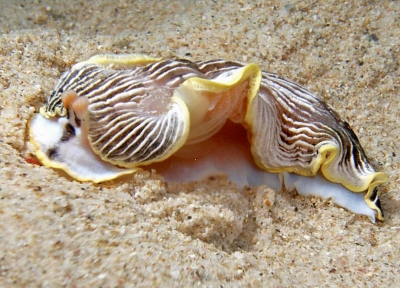
Concerning message #15650:
Hi Bill,
I live on Bonaire part time, and during the past six weeks I've found 3 different Armina nudibranchs in the sandy area just north and just south of the Sand Dollar dock at Bari Reef. All were found during the day, and were mostly or partially buried in the sand. I don't have a photo of the third Armina, but the first 2 are similar in appearance with stripes at the head and the tail, but none in the middle. The dark stripe down the face is slightly different. They both lack the "smile" of the Smiling Armina in the "Reef Creature Identification" book.
Locality: Bari Reef, 10 to 15 foot depth, Bonaire, Netherlands Antilles, Caribbean, October and November 2006, sandy bottom. Length: 1 to 1 1/4 inches. Photographer: Marge Lawson.
Are these the same as Les Wilk's Armina wattla, or are they a different variety?
Marge Lawson
margebonaire@yahoo.com
margebonaire@yahoo.com
Lawson, M. I., 2006 (Nov 20) Re: Armina wattla (?) from Bonaire. [Message in] Sea Slug Forum. Australian Museum, Sydney. Available from http://www.seaslugforum.net/find/18388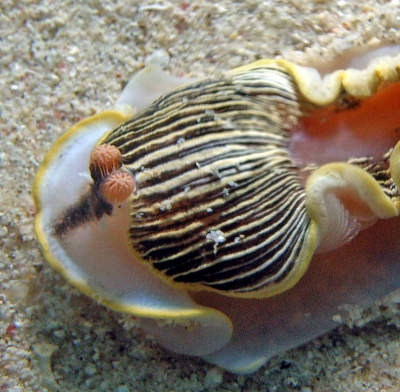
Dear Marge,
Yes I think these are the same as the animal in Les Wilk's message. I' afraid identifying Caribbean species of this group is difficult at present because we don't know enough about them - how many species there are? how variable is each species? More importantly a number of species have been described from preserved animals, so we really have no idea what their living colour pattern is. I really don't understand nudibranch specialist naming new species from preserved decolourised animals. Even 18th century ornithologists realised they need to include colour in their descriptions of new species of birds.
Be that as it may, Marcus & Marcus (1967) described A. wattla from preserved material. One distinctive 'colour' feature in the preserved specimen is a median black band on the oral hood as in your animals. For this reason I have identified this species as A. wattla. The animal recently illustrated in Caribbean Sea Slugs [Valdes, Hamann, Behrens & DuPont,. 2006] as A. wattla does not seem to have this black band, or the bright colour border of your animal, so one of us is probably wrong. I think the black band is probably more indicative of the Marcus species, after all the lack of colour in their description is most probably because their specimens were preserved and decolourised.
The other interesting point is why your animals were visible during day light hours. Large arminids are usually hiding in the sand during the day. I think the answer is related to the large bite marks on both specimens. The pink regions without lines, that your mention, are bite marks where something - presumably a fish - has bitten out a large patch of mantle tissue. Perhaps they are sitting exposed on the surface because they were badly injured at night, or perhaps they were bitten because they have come to the surface during daylight hours.
Best wishes,
Bill Rudman
Armina wattla (?) from Bonaire
January 26, 2006
From: Les Wilk
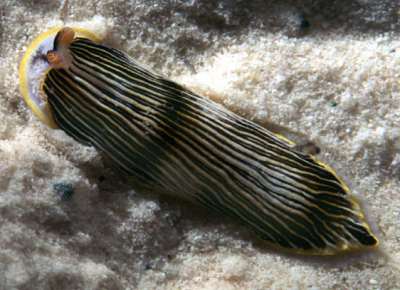
Hi Bill;
This may be an Armina wattla. It seems to be the same as the Armina sp. in the Humann and Deloach book.
Locality: Tori's Reef, Bonaire, Caribbean. Depth: 20 feet. April 2004. sandy bottom. Photographer: Les Wilk
Les Wilk
wilk@reefnet.ca
Wilk, L., 2006 (Jan 26) Armina wattla (?) from Bonaire. [Message in] Sea Slug Forum. Australian Museum, Sydney. Available from http://www.seaslugforum.net/find/15650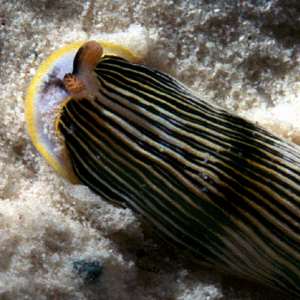
Dear Les,
It certainly looks similar to Dave Elliott's earlier photo [#7883] and it has the characteristic black line down the midline of the oral veil. Looking at your photo I notice also that the orange rhinophores have a black band down the anterior edge - a feature also present in Dave's animal. The photo in the Humann and Deloach book also shares these features. Your record from Bonaire suggests this species is widespread in the Caribbean.
Of course it should be said that it will be important to look at the anatomy of these animals before we can be sure of their identity.
Best wishes,
Bill Rudman
Armina wattla? from the Caribbean
September 28, 2002
From: Dave Elliott


This picture was taken in July, 2002 in the waters off the Caribbean Island of Dominica. The site was called Champagne, because of the sulfur bubbles coming out of the sand. The object was probably two inches long and was slowly moving across the open sandy bottom. Could somebody please identify it? Common names as well as scientific names would be appreciated.
Dave Elliott
delliott33@cogeco.ca
Elliott, D., 2002 (Sep 28) Armina wattla? from the Caribbean. [Message in] Sea Slug Forum. Australian Museum, Sydney. Available from http://www.seaslugforum.net/find/7883Dear Dave,
This is an arminid nudibranch, almost certainly of the genus Armina. Species of Armina are usually sand-dwellers and feed on sand-dwelling cnidarians such Sea Pens, and in some cases Soft Corals.
As to identifying your species, that could be a bigger problem as little detailed work has been done on the group in the Caribbean. Eveline Marcus (1977) in her checklist of warm water western Atlantic opisthobranchs, lists 3 species of Armina, including the Mediterranean species, Armina tigrina Rafinesque, 1814. The two species which were described from the western Atlantic are Armina mulleri (von Ihering, 1886) and Armina wattla Marcus, 1967.
The colour of the living animal of Armina mulleri was redescribed by Marcus & Marcus (1967) as "has a black notum, with light ridges, a yellowish hyponotum and bright pink sole" Unfortunately there are many species with very similar colour patterns. However, although Armina wattla has only been reported once, [from Georgia, USA] features of its colour pattern do match your photo rather well. Unfortunately the Marcus' description s based on preserved animals but they do describe the preserved animals as 'whitish with black pigment in the furrows between the notal ridges ... in the middle of the [oral] veil .....". In the drawings accompanying the description there is a black band running down the middle of the oral veil just as in your photo. However there is no mention that the black continues along the edge of the oral veil as well.
Basically, I can't give a definite identification, as we know too little about the arminids from the Caribbean. However there is a possibility your animal could be Armina wattla.
• Marcus, Ev. & Marcus, Er. (1967) Some opisthobranchs from Sapelo Island, Georgia, U.S.A. Malacologia, 6(1-2): 199-222.
• Marcus, Er. & Marcus, Ev. (1967) American opisthobranch mollusks. Part 1, Tropical American opisthobranchs. Studies Tropical Oceanography, Miami, 6(1-2): 1-137. (Figs 1-150, Pl.1, figs 1-9)
• Marcus, Ev. (1977) An annotated checklist of the western Atlantic warm water opisthobranchs. J. Moll. Stud. (Suppl. 4): 1-23.
Best wishes,
Bill Rudman
